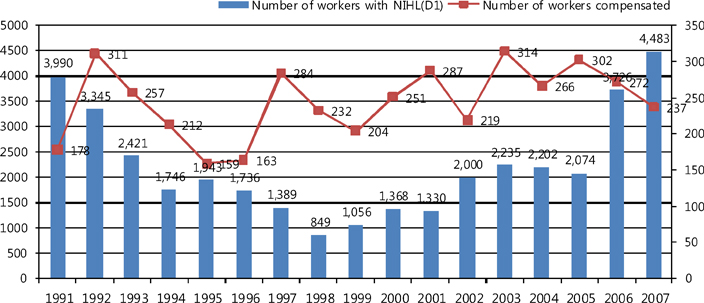Hanyang Med Rev.
2010 Nov;30(4):326-332.
Occupational Diseases of Noise Exposed Workers
- Affiliations
-
- 1Department of Occupational and Environmental Medicine, University of Ulsan, College of Medicine, Ulsan University Hospital, Ulsan, Korea. leejh@uuh.ulsan.kr
Abstract
- Noise-induced hearing loss (NIHL) is one of the most common occupational disease, which carries not only an enormous cost in workers' compensation but also a even greater social cost due to loss of productivity and damage to quality of life. However, the unquestionable impact of occupational noise, NIHL is sometimes underestimated by the majority of workers because of its largely slow and insidious nature. High levels of occupational noise produce stress reactions, disturbances in communication, task performance, as well as development of hypertension, cognitive defects. Approximately 89% of the total disease burden (incidence of disability-adjusted life years, DALYs) is in 15-59 years age group and more than four millon DALYs were lost to NIHL. NIHL is incurable and irreversible at present. However, it is preventable, and it is necessary that preventive programmes be implemented. Within hazard prevention and control program should be involve following elements: 1) the work process: install quieter equipment, promote good maintenance; 2) the workplace: use noise enclosures of acoustic equipment; 3) the workers: set up work practices and other administrative controls on noise exposure, and provide audiometric test and hearing production, and workers' education programmes; and 4) child and adolescence: prevent healthy hearing from over exposure of environmental noise (eg. noisy toy, MP3, discotheque).
MeSH Terms
Figure
Reference
-
1. NIOSH. Criteria for a recommended standard: occupational noise exposure. Revised criteria 1998. Cincinnati, OH: National Institute for Occupational Safety and Health.2. WHO. Occupational and community noise. 2001. Geneva: World Health Organization;(Fact Sheet No. 258).3. Ministry of Labor. Annual report on the work environmental management 2007. 2008. Ministry of Labor;(Korean).4. Marisol CB, Diarmid CL, Kyle S. Occupational noise-Environmental burden of disease series No. 9. 2004. Geneva: World Health Organization.5. American Academy of Audiology. Preventing Noise-Induced Occupational Hearing Loss: position statement. 2003. available at http://www.audiology.org/.6. Daniell WE, Stover BD, Takaro BK. Comparison of criteria for significant threshold shift in workplace hearing conservation programs. J Occup Environ Med. 2003. 45:295–304.
Article7. Ahmed HO, Dennis JH, Badran O, Ismail M, Ballal SG, Ashoor A, Jerwood D. Occupational noise exposure anf hearing loss of workers in two plants in eastern Saudi Arabia. Ann Occup Hyg. 2001. 45:371–380.
Article8. Jang JK, Chung KJ. A study on the management of noise in work-environments. 2007. Occupational Safety and Health Research Institute, Korea Occupational Safety and Health Agency.9. de Hollander AME, van Kempen EEMN, Houthuijs DJM, van Kamp , Hoogenveen RT, Staatsen BAM. Environmental noise: an approach for estimating health impacts at national and local level. 2004. Geneva: World Health Organization.10. Murray CJ, Salomon JA, Mathers C. A critical examination of summary measures of population health. Bull World Health Organ. 2000. 78:981–994.11. Concha-Barrientos M, Nelson DI, Driscoll T, Steenland NK, Punnett L, Fingerhut M, Prüss-Üstün A, Corvalan C, Leigh J Tak S. Selected occupational risk factors. 2004. Geneva: World Health Organization.12. NIOSH. Noise-induced hearing loss. 1991. Cincinnati, OH: National Institute for Occupational Safety and Health.13. Sulkowski WJ. Luxon LM, Prasher D, editors. Occupational noise in Noise and its effects. 2007. West Sussex, England: John Wiley & Sons Ltd.14. Lee JH, Cha TJ, Kim JR, Kang WC, Yaang SR, Lee CR, Yoo CI. Cohort study for the effect of chronic noise exposure on blood pressure among male workers. Korean J Prev Med. 2002. 35:205–213.15. Prasher D. Luxon LM, Prasher D. Factors determining an individual's susceptibility to noise damage. Noise and its effects. 2007. West Sussex, England: John Wiley & Sons Ltd.16. Daniel E. Noise and hearing loss: a review. J Sch Health. 2007. 77:225–231.
Article
- Full Text Links
- Actions
-
Cited
- CITED
-
- Close
- Share
- Similar articles
-
- Noise Induced Hearing Loss of 3 military workers that satisfied guidelines of occupational disease in Korean Occupational Safety & Health Act
- The Etiologic Fraction of Isocyanate-related Asthma in Isocyanate-exposed Workers
- Occupational Noise Exposure and Serum Lipids in Manufacturing Company Workers
- The Changes of Hearing Threshold Level in Noise-exposed Workers
- A Follow-up Study on the Personal Noise Exposed Dose and Hearing Loss


